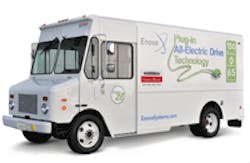FCCC rolls out all-electric and gasoline stepvan chassis models
Responding to a changing marketplace on the one hand and to customer demands on the other, Freightliner Custom Chassis Corp. (FCCC) has developed an all-electric plug-in walk-in van (WIV, aka “stepvan”) chassis and will also release a gasoline-fueled chassis for the first time.
The all-electric chassis was developed in partnership with Enova Systems , a developer and producer of electric and hybrid-electric drive system technologies for commercial vehicle OEMs, and is built on FCCC’s MT-45 WIV platform, Jonathan Randall, FCCC sales & marketing director, said at a news conference held at the FCCC booth on the floor of The Work Truck Show held in St. Louis last week by the National Truck Equipment Assn.
“In partnership with Enova we have developed an all-electric chassis to meet the environmental, economic and performance needs of our commercial vehicle customers,” said FCCC president Bob Harbin in a prepared statement. “Our vision is clearly focused on transitioning the all-electric chassis into the mainstream of our walk-in van production programs.
“Unlike competitive models, our all-electric chassis is custom-built from the ground up for the walk-in van market, integrating the proven ergonomic advantages of WIV bodies,” Harbin added. “Competitor chassis are a cab chassis configuration and end up as box trucks typically built for the trucking industry. Competitor products do not offer the ergonomic benefits and safety features of a WIV such as curb-side exit, walk-through cargo area, direct access to cargo area from driver’s station, etc.”
“Collaborating with FCCC has enabled us to achieve our shared goal of introducing all-electric drive technology into the walk-in van market,” said Mike Staran, president & CEO of Enova Systems, at the conference.
Randall pointed out that “FCCC initiated our all-electric project well before stimulus money and federal grants were available for alternative-power transportation projects. FCCC viewed the all-electric project as the logical next step in its alternative-power product offerings, as well as a strategic opportunity to continue its leadership role in the WIV industry.”
According to Randall, on “select delivery and service routes, studies show that customers will save up to $15,000 per vehicle annually compared with traditionally powered walk-in vans.” He said the all-electric’s quiet operation will improve driver comfort and said a flat-leaf spring front and rear suspension will allow for “a smooth, solid ride that minimizes cargo shifts on uneven road surfaces.”
The development program involved integrating Enova’s 120kW all-electric drive system technology into the MT-45 chassis. Aimed at the P&D operator, the MT-45 boasts a GVWR of 14,000 to 19,500 lbs.
“Collaborating with FCCC has enabled us to achieve our shared goal of introducing all-electric drive technology into the walk-in van market,” said Mike Staran, president & CEO of Enova Systems at the conference.
Powered by Tesla Motors’ lithium ion batteries, the chassis is 100% electric-- including its HVAC system-- making it the only such chassis available, according to Randall. He added that FCCC is the first OEM to utilize Tesla batteries for commercial applications.
The all-electric drive system features battery packs that provide a driving range of up to 100 miles on a single charge. The battery pack will charge from fully depleted to fully charged in six to eight hours.
The batteries also capture and store energy during the regenerative braking phase of the vehicle’s operation. The regenerative braking system saves energy by recycling and storing it, which can then be reused to propel the vehicle instead of losing it to heat, as is the case with traditional brakes. Regenerative braking also reduces friction during braking, resulting in less brake wear and extended brake life.
Other features include a parking pawl within the gear box and a push-button shifter for improved efficiency.
The all-electric MT-45 chassis is expected to go into full production during the first quarter of 2011 and will undergo testing with major U.S. pickup and delivery fleets.
Randall noted that along with the new all-electric chassis, FCCC has extensive experience manufacturing compressed natural gas (CNG) WIV chassis; currently manufactures hybrid-electric vehicle (HEV) chassis; and will offer full production of its hydraulic hybrid vehicle (HHV) walk-in chassis in the fourth quarter of this year.
Turning to the new gasoline-fueled chassis offering, Randall said it was designed at customer request to address the large segment—45%-- of the WIV market that still runs gas jobs. The gasoline-powered chassis is built on the MT-45 and MT-55 chassis platform and the new chassis was engineered “to provide similar core benefits of the MT-45 and MT-55, including the same outstanding reliability, durability, serviceability and performance,” stated Randall.
“The gasoline-powered chassis was designed and engineered by FCCC after speaking with numerous customers and recognizing there was a market desire for FCCC chassis with this powertrain,” said Randall.
The gas model comes standard with an Allison 1000/2000 Series automatic transmission and General Motors 6.0-liter V8 engine, with a horsepower range of up to 320. 20 horsepower range. According to FCCC, this is the first time a 6.0-liter GM engine has been mated with an Allison 1000/2000 Series transmission.
The gas chassis has a GVWR of 14,500 to 23,000 lbs. It is currently undergoing durability testing and is slated to go into production during the third quarter of 2010.
